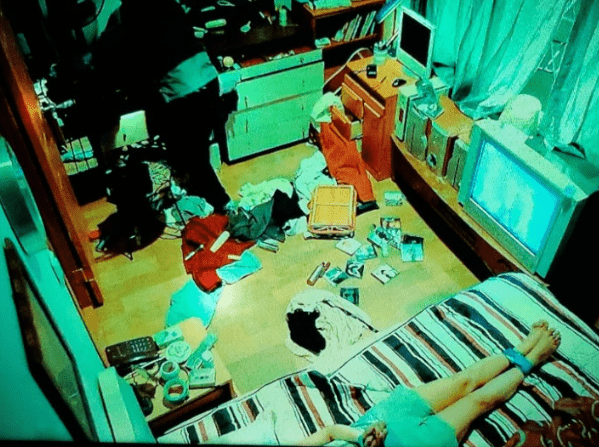The Perfect Alibi and the Killer Who Knew The Dogs’ Names

1. THE HOOK: The House of Chaos and the Sealed Face
On May 7, 2008, at 7:25 PM, a husband returned to his home in Seodaesin-dong, Busan, South Korea. The front gate, which should have been locked, was inexplicably open. Inside, the house was a complete disaster zone.
In the main room, he found his wife brutally murdered. Her face and hands were completely covered and bound with green duct tape (청테이프).
Initial police assessment pointed to a botched robbery: a thief must have broken in, murdered the housewife with duct tape, ransacked the house, and fled with valuables.
However, the timeline immediately raised red flags:
- The husband testified his wife was alive when he left around 1:00 PM.
- A postal worker testified that when he visited around 2:00 PM, he rang the bell and called out, but no one answered.
This narrow one-hour window concealed a deeply complex and highly orchestrated crime.
[A high-contrast, moody photo focusing on a spool of crumpled, dark green duct tape on a worn wooden floor, suggesting violence and concealment.]
2. THE UNCUT CORE: A Deliberate and Flawed Staging
The investigation quickly peeled back the initial assumption of robbery, revealing a sophisticated attempt at misdirection.
File 2.1. The Financial Mismatch
The victims were not wealthy. In fact, they were deep in personal debt. This immediately made the motive of a typical robbery highly suspicious.
File 2.2. The Powder Trail
The crime scene was chaotic—too chaotic. Items were scattered too widely to suggest a panicked, desperate search for cash. More critically, a trail of cheap cosmetic powder was found, marked with a sneaker print.
Forensics determined the powder container was robust; it would not have spilled simply by being dropped. Someone must have deliberately opened the lid and removed the puff to scatter the powder, attempting to simulate the hurried chaos of a thief.
File 2.3. The Perfect Tape and the Post-Mortem Concealment
The most chilling evidence was the duct tape itself.
- The Anomaly: The tape wrapped around the victim’s face and hands was clean, without any wrinkles or creases. If the victim had struggled, the tape would have been twisted or crumpled.
- The Conclusion: The victim did not die from suffocation by the tape. She was likely asphyxiated by another means (a pillow or cushion) and the duct tape was applied post-mortem, meticulously smoothed to suggest a frantic struggle that never happened. Her hands were also bound in front, not behind, which contradicts typical restraint procedures.
File 2.4. The Impossible Footprint
The ultimate proof of staging came from the sneaker print near the window of the main room where the body was found. An audio speaker was positioned by the window, and a powder-dusted footprint was found on top of it.
The critical flaw? The sneaker was facing inward, towards the room, not outward towards the escape route.
UncutCore Analysis: The killer murdered the victim, carefully wrapped the body in pristine duct tape, deliberately opened the powder to create a fake scene, and then stepped onto the speaker, facing inward, to ensure the powder trail was laid—a highly choreographed piece of theatrics to mimic a robbery gone wrong.
3. THE FOG OF DEATH: The Electrical Deception
To further cloud the investigation, the killer took one final, crucial step:
- The Electric Blanket: When the body was discovered, the victim’s electric blanket was turned on high.
- The Effect: This prevented the body’s temperature from dropping naturally, making it impossible to accurately estimate the time of death. Given the warm weather in Busan in May, running the blanket on high was highly unnatural, pointing directly to the killer’s deliberate intent to dismantle the timeline.
This single act made it impossible to definitively confirm or deny any suspect’s alibi.
4. THE ONLY WITNESS: The Silent Dogs and The Husband’s Alibi
All evidence pointed to a killer who was intimate with the victim and the house:
- The Quiet Dogs: Neighbors testified the victim’s dogs were fiercely territorial and would bark loudly at any stranger. On the day of the murder, the dogs were completely silent. This suggests the killer was someone extremely familiar with the household—someone the dogs would not view as a threat.
Initially, this evidence put the husband under immediate suspicion. He was the most familiar person to the dogs and, financially, he was the primary beneficiary—or so it seemed.
- The Financial Reversal: Investigators discovered the couple was only in a common-law marriage (사실혼), meaning they were not legally registered as married. The victim’s assets were in her name, and her three life insurance policies were payable to her family, not her husband.
- Her death would financially devastate the husband, leaving him with nothing.
- The Debt Angle: However, the victim had taken out substantial private debt (사채) using her name. Since they were not legally married, her death would effectively erase the husband’s liability for that debt. The motive shifted from gaining insurance money to escaping crippling debt.
Despite the strong circumstantial case, the untraceable time of death (due to the electric blanket) made it impossible to place the husband at the scene during the critical one-hour window (1 PM to 2 PM).
5. COLD CASE CONNECTIONS: The Tape Killer Shadow
This case shares striking similarities with the Gwangju Female College Student Tape Murder that occurred four years earlier (2004).
- Difference: In the Gwangju case, the victim was alive when taped and suffocated. In the Busan case, the tape was applied post-mortem.
- UncutCore Connection: It is plausible that the Busan killer studied the Gwangju case via media reports and used it as a blueprint, deliberately modifying the taping method and adding the electric blanket tactic to create a crime that was both recognizable (Tape Murder) and immune to timeline reconstruction.
The Busan Western Police Station (부산서부경찰서) continues the investigation indefinitely, as the statute of limitations was indefinitely suspended in 2015 for crimes of this nature.
UncutCore Final Hypothesis: The killer was not a frantic robber but a calm, calculated individual driven by the extreme need to erase the victim’s massive debts, thereby clearing his own liability. The meticulous staging, the silent dogs, and the surgical use of the electric blanket all point to a killer who possessed not only intimate access to the home but also the cold-blooded composure necessary to defeat every known forensic tool of the time.
Was the elaborate staging intended not just to fool the police, but to send a chilling, private message to the victim’s family or debtors that the debt—and the victim—were now definitively erased?
[A close-up of a cheap, vintage powder compact or container on a floor, showing a small amount of powder spilled, contrasting the simple object with its role in concealing a murder.]

